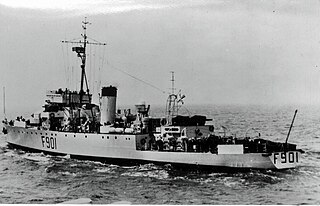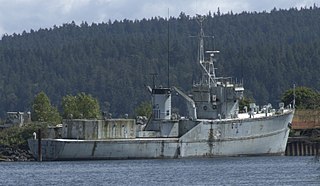HMCS Fortune was a Bay-class minesweeper built for the Royal Canadian Navy. Named for Fortune Bay, located in Newfoundland, the vessel served in the Royal Canadian Navy for ten years before being sold for commercial purposes. Renamed MV Edgewater Fortune she saw service as a commercial yacht.
HMCS Chaleur was a Bay-class minesweeper that served in the Royal Canadian Navy for three and a half months in 1954 before being sold to the French Navy to become La Dieppoise. The ship was named for Chaleur Bay, located between Quebec and New Brunswick. Her name was given to her replacement, Chaleur. As La Dieppoise, the vessel served as a coastal patrol vessel in the France's Pacific Ocean territories. The ship was taken out of service in 1987. In January 1988, the vessel was sunk as an artificial reef in the lagoon of Nouméa.
HMCS Miramichi was a Bay-class minesweeper that served in the Royal Canadian Navy and the French Navy. She was named Miramichi Bay, located at the mouth of the Miramichi River in New Brunswick. Entering service in 1954, the vessel served in the Royal Canadian Navy for only a few months before transferring to the French Navy. Renamed La Lorientaise, the ship was used as a minesweeper before converting to a patrol vessel in 1973. The ship was discarded in 1986.

The Bay-class minesweepers, also known as the Gaspé-class minesweepers, were a class of minesweepers operated by the Royal Canadian Navy (RCN) and Canadian Forces (CF) during the Cold War. Their design was similar to the British Ton-class minesweepers.
HMCS Comox was a Bay-class minesweeper built for the Royal Canadian Navy during the Cold War. The vessel was named for Comox Harbour, a bay in British Columbia. The minesweeper was later transferred to the Turkish Navy where she was renamed Tirebolu and served until 1996.

HMCS Wallaceburg was an Algerine-class minesweeper that served in the Royal Canadian Navy during the Second World War as a convoy escort during the Battle of the Atlantic. After the war the vessel was used from 1950 to 1959 for cadet training. In 1959 she was sold to the Belgian Navy and served until 1969 as Georges Lecointe, the second ship to be named after Georges Lecointe.
HMCS Thunder was a Bay-class minesweeper that served in the Royal Canadian Navy during the Cold War. The ship was named for Thunder Bay. This was the third vessel to carry the name and the second in the class, replacing a previous vessel sold to France. The minesweeper entered service in 1957 and was paid off in 1997.
HMCS Thunder was a Bay-class minesweeper that served in the Royal Canadian Navy for three and a half months in 1954 before being sold to the French Navy to become La Paimpolaise. The ship was named for Thunder Bay and was the second vessel to carry the name. Her name was given to her replacement, HMCS Thunder.
HMCS Quinte was a Bay-class minesweeper that served in the Royal Canadian Navy during the Cold War. Entering service in 1954, the minesweeper was the second ship to bear the name. The ship was taken out of service in 1964 and declared surplus in 1965.
HMCS Chignecto was a Bay-class minesweeper that served in the Royal Canadian Navy during the Cold War. The ship entered service in 1953 and in 1954, was transferred to the French Navy and renamed La Bayonnaise. Serving as a minesweeper until 1973, the ship became a territorial patrol ship and remained in service until 1976. La Bayonnaise was broken up for scrap in 1977.
HMCS Chignecto was a Bay-class minesweeper that served in the Royal Canadian Navy during the Cold War. Entering service in 1957, the minesweeper was used primarily as a training vessel on the Pacific coast of Canada. Discarded in 1998, the ship was broken up in 1999.
HMCS Cowichan was a Bay-class minesweeper that served in the Royal Canadian Navy during the Cold War. The minesweeper entered service in 1953 and was transferred to the French Navy in 1954. Renamed La Malouine, the ship was converted to a territorial patrol vessel in 1973 and remained in service until 1977. La Malouine was sunk as a target ship in 1985.

HMCS Cowichan was a Bay-class minesweeper that served in the Royal Canadian Navy during the Cold War. Entering service in 1957, the minesweeper was used primarily as a training vessel on the Pacific coast of Canada. Decommissioned in 1997, the ship was sold in 1999 for conversion to a yacht.
HMCS Fundy was a Bay-class minesweeper that was constructed for the Royal Canadian Navy during the Cold War. The minesweeper entered service in March 1954 and was transferred later that month to the French Navy. Renamed La Dunkerquoise, the ship was converted to a territorial patrol vessel in 1973 and remained in service until 1984. La Dunkerquoise was discarded in 1986.
HMCS Fundy was a Bay-class minesweeper that was constructed for the Royal Canadian Navy during the Cold War. Entering service in 1956, the vessel was used as a training ship on the West Coast of Canada for the majority of her career. Fundy was decommissioned in 1996 and the fate of the vessel is unknown.
HMCS Gaspé was a Bay-class minesweeper that was constructed for the Royal Canadian Navy during the Cold War. The vessel entered service in 1953 and remained with the Royal Canadian Navy until 1958. That year, the ship was transferred to the Turkish Navy and renamed Trabzon. The vessel remained in service until 1991.
HMCS James Bay was a Bay-class minesweeper that was constructed for the Royal Canadian Navy during the Cold War. Entering service in 1954, the ship served on the West Coast of Canada until 1964 when James Bay was decommissioned. The minesweeper was sold in 1966 for use as an offshore oil exploration vessel.

HMCS Miramichi was a Bay-class minesweeper that was constructed for the Royal Canadian Navy during the Cold War. Entering service in 1957, the vessel was used as a training ship on the West Coast of Canada for the majority of her career. Miramichi was decommissioned in 1998 and the vessel's fate is unknown.
HMCS Resolute was a Bay-class minesweeper that was constructed for the Royal Canadian Navy during the Cold War. Entering service in 1954, the ship served on the East Coast of Canada until 1964 when Resolute was decommissioned. The vessel was discarded in 1965.
HMCS Ungava was a Bay-class minesweeper that was constructed for the Royal Canadian Navy during the Cold War. Entering service in 1954, the minesweeper was paid off in 1958 and transferred to the Turkish Navy. Renamed Tekirdağ, the ship remained in service until 1991 and was broken up in 2002.


